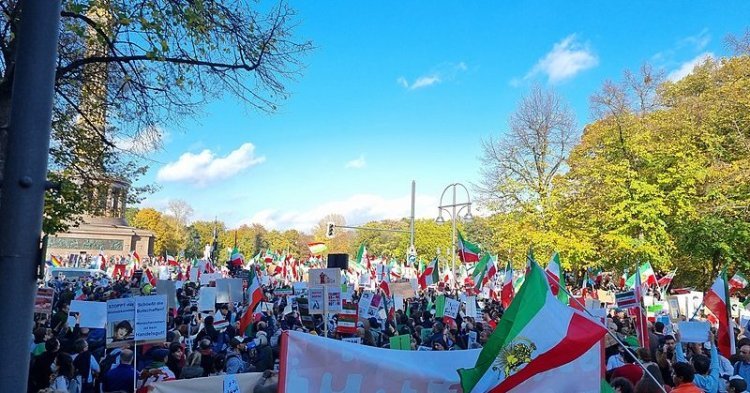The death of Mahsa Amini, a 22-year-old Kurdish-Iranian woman, on September 16th has led to protests all over Iran. Amini was visiting Tehran with her family when she was arrested by the moral police for not wearing her hijab correctly. After her arrest, Amini died in a hospital in Tehran, and later leaked evidence revealed that she had died as a consequence of police brutality.
The protests that followed Amini’s death have now been going on for weeks and have spread throughout the whole country. Analysts and international observers already claim that the rise in protests, and the spontaneous movement resulting from it, are unprecedented for Iran, and even more widespread than the protests of 2017 and 2019.
Initially, it was mainly women participating in the protests by removing publicly their hijabs and cutting their hair. As the days went by, young people and other opponents of the regime also joined the manifestations. As of now, Amnesty International reports that over 1,000 people are being detained, and at least 185 people were killed in the protests, including 17-year-old Nika Shakarami and 16-year-old Sarina Esmailzadeh, whose shocking deaths have been reported by international media outlets just like Amini’s.
Meanwhile, Supreme Leader Khamenei blames foreign powers, namely the US and Israel, for fuelling the unrest. However, this time protests have managed to transcend the ethnic and social divisions of the country, reaching the Kurds regions in the north and northwest and the Baloch in the southeast, as well as the holy cities of Mashhad and Qom. Despite the intimidations of the regime, the protests continue to gather momentum, suggesting that these protests might be a turning point for the regime.
A first factor to consider is the composition of the protests, which seem to transcend the nations’ differences. This aspect is probably a result of Amini’s identity itself as a young girl, and from a rural area, making her a strong unifying symbol and favouring the identification by many outside the capital. Furthermore, it has been mostly the youth leading the protest, triggering a chain reaction of solidarity by other generations. This time, the young protesters have shown a never-before-seen lack of faith in the Islamic Republic, and they believe there is no possibility for reform from within. Interestingly, in this request for a radical change it is easy to draw a parallel to the youth that has protested in other areas of the world for other causes, namely climate change, but clearly with the same sense of justice and values, signalling how a globalised youth is taking up space everywhere. In addition, over the last few days, members of the military have deserted and joined the protests, feeling that the ideals of the regime have failed them as well. This last factor is, apparently, frightening the regime more than anything, and it is being reported that Arab mercenaries have joined the Iranian military to compensate for the internal divisions.
Another key aspect to consider is the incredible power social media is having in spreading the word globally and among young people. Right after the start of the protests, not only were the violent images of the repression viewed by millions worldwide, but the act of cutting one’s hair, as an act of solidarity with Iranian women, was replicated by many all over the world. The social media response was so powerful that it spilled over to real life and real-life politics until, on October 4th, Swedish MEP Abir Al-Sahlani cut a string of her hair in the European Parliament. In a way, the replicability of such a gesture has made it a viral support tool that has kept the attention of international media and public opinion focused on Iran, something vital for the morale of the protesters. Further confirmation of how the internet is being key during this time of political turmoil, has been the recent hacking of Iranian state television on October 8th by a dissident group inviting the viewers to take the streets and join the protests.
The aspects highlighted so far, call for reflections on whether the international community, particularly the EU, should have a role in the matter and what it could mean for human rights and democracy everywhere.
Currently, the fight for women’s rights as human rights and the feminist movement have seen an important rise, particularly after the #MeToo movement shed light on the endemic sexism and the systemic discrimination of women in society. While this has led to positive improvements in women’s conditions and the spread of gender mainstreaming practices, the positive effects have stayed mainly in the West, contributing to the failure of the feminist movement to really adopt an intersectional perspective. Consequently, the movement has failed to incorporate the fight for women’s rights in other areas of the world, in particular when those battles have taken up different forms compared to western ones. In reality, the safeguarding of human rights and, particularly, women’s rights, should be considered as a part of a global agenda, just like climate change and democracy, that only further integration on a global level could defend, especially in a time in which the ultra-conservatives are actively limiting women’s freedom in multiple areas of the world.
As for the role of the international community in a possible development of democracy in Iran, it has to be recognised that, over the last few years, the international community has had ambivalent relations with the Iranian government, from Donald Trump’s withdrawal from the Nuclear Deal, to the EU being Iran’s second trade partner. The action of the EU towards Iran has clearly been aimed at avoiding complete closure and isolation, while hopefully creating fertile ground for democracy and supporting Iranian civil society. However, the current events might put the international community at a crossroads, as what is happening now in Iran might turn to the point of choosing between supporting the rise of democracy and maintaining economic interests. This choice could be particularly difficult for the European Union, whose member states have had key economic interests with Iran since the Iranian Deal, while the European Parliament seems to have taken a clear stance, as previously mentioned. Therefore, the question remains whether the EU will follow its value-based approach to foreign policy, or if it will surrender to the different priorities of the member states.
While it could be too soon to think about what the European Union could possibly do, it is important to highlight how, even in this matter, this should be the EU’s duty and role on a global level. Above all, to be faithful to its values the EU should find a way of supporting the fight for human rights and democracy everywhere. This includes also being first in line in promoting integration structures on a global level, the only possible path to grant human rights globally, and possibly stop the receding of democracy in the world.
Eventually, significant uncertainties regarding the possible outcomes of the protests remain. In fact, the lack of political leadership is preventing the development at this stage of a political perspective for the protest movement. This is a necessary step to reach any change or reform in the long run but, most importantly, to bring the international community to take a role in the path towards democracy for Iran. On the other hand, there seem to be some favourable factors that could suggest that this movement could be the final nail to the coffin of the regime. However, no matter how favourable contextual factors might be, the politicisation of any protest is the key factor to reaching real change.


Follow the comments: |
|
